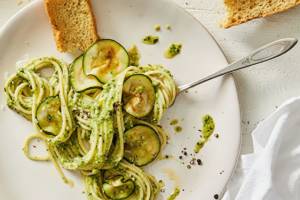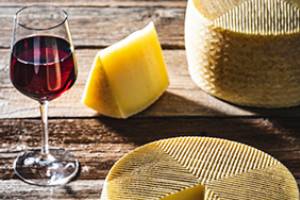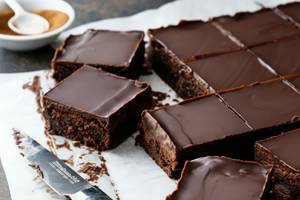
 A delicious dish of flan, or crème caramel. Photo by Rafa Irusta | Dreamstime. A delicious dish of flan, or crème caramel. Photo by Rafa Irusta | Dreamstime.
September 2006
Last Updated June 2025
|
 |
Custard Glossary: Different Types Of Custard
Page 3: Terms & Definitions: D ~ F
This glossary includes not only the different types of custard but the recipes that use them; for example, that favorite French pastry, the éclair. This page includes terms such as éclair, flan, and frozen custard.
Use this index bar to visit the appropriate glossary section.
a b c d e f g h i j k l m n o p q r s t u v w x y z
This glossary is protected by copyright and cannot be reproduced in whole or part.
You are welcome to link to it.
|
DIPLOMAT
Crème diplomat is a light, airy cream that combines the richness of pastry cream (crème pâtissière) with whipped cream, and often some gelatin for stability, which makes it more stable than crème légère: smooth, airy, and holds its shape.
One of the best-known uses of diplomat cream is in Princess Cake (Prinsesstårta), a traditional Swedish dome-shaped cake that combines layers of vanilla cake with jam and a cap of diplomat cream. It’s topped with a blanket of marzipan, often tinted green and crowned with a pink marzipan rose
|
|

Diplomat cake (photo © King Arthur Baking, photography by Rick Holbrook and food styling by Kaitlin Wayne).
|
ÉCLAIR
A finger-shaped pastry made of pâte à choux with a glacé icing, filled with custard or whipped cream. It is known to have originated in France around the turn of the 19th century. Many food historians speculate that éclairs were first made by Marie-Antoine Carême (1874-1833), the first “celebrity chef,” considered the founder and architect of French haute cuisine, cookbook author, and chef to Talleyrand, the future George IV of England, Emperor Alexander I of Russia and Baron James de Rothschild.
|
|
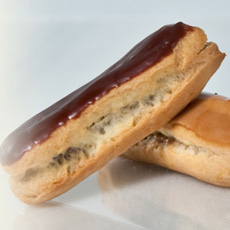
Chocolate and caramel éclairs. Photo courtesy Christophe Artisan Chocolatier.
|
The Oxford English Dictionary traces the term “éclair” in the English language to 1861. The first known recipe for éclairs appears in the 1884 edition of the Boston Cooking-School Cook Book, edited by Mrs. D.A. Lincoln. “Éclair” is the French word for lightning. It is suggested that the pastry received its name because it glistens when coated with confectioner’s glaze. We would suggest that it is because they are so popular that they disappear as quickly as lightning.
ENGLISH CREAM
See crème anglaise.
ENGLISH TRIFLE
See trifle.
FLAN
The name for crème caramel in Spanish-speaking countries. It is the national dessert of Spain. In Mexico, dulce de leche is often used instead of caramel syrup. See the photo at the top of the page.
FLAN (TART)
A second meaning for flan is an open-faced pie, similar to a tart, filled with pastry cream and covered with fresh fruit.
|
|
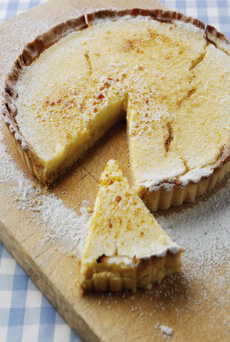
A tart filled with custard or pastry cream is also called a flan. Photo courtesy FAGE.
|
FLOATING ISLAND
Also known as oeufs à la neige, “snow eggs,” a delicate dessert of stiffly beaten, sweetened egg white mounds (meringue “islands”) that have been poached in milk, then floated in a thin custard sauce. In France, île flottante, “floating island,” is a liqueur-sprinkled sponge cake spread with jam, and topped with nuts and whipped cream, surrounded by a pool of custard. Cocoa powder and confectioner’s sugar can be added to whipped egg whites to make a chocolate floating island.
|
|
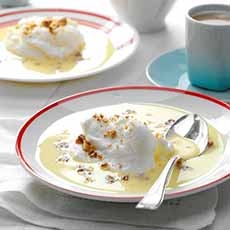
Floating Island (photo © Taste Of Home). |
FRANGIPANE
Frangipane is an almond custard filling, a thick type of crème pâtissière mixed with powdered almonds or crushed macarons. It is used as a filling for tarts or crêpes.
FRENCH ICE CREAM
Ice cream with a cooked egg-custard base. See crème anglaise.
FROZEN CUSTARD ICE CREAM
Another term for French ice cream, made with egg yolks and cream, the ingredients for custard. In the U.S., it is not soft-serve ice cream. However, “frozen custard” was served as early as the late 1800s, long before the invention of soft-serve.
The U.S. Department of Agriculture standards recognize the term “frozen custard” as “an egg-based ice cream.“
In addition. “It shall also contain for each ninety pounds thereof not less than (a) five dozen of clean wholesome egg yolks, (b) one and five-tenth pounds of wholesome dry egg yolk containing not to exceed seven percent of moisture, (c) three pounds of wholesome frozen egg yolk containing not to exceed fifty-five percent of moisture, or (d) the equivalent of egg yolk in any form.
Thus, soft-swirled ice cream called “frozen custard” is not frozen custard: It is soft-serve ice cream. The term “frozen custard” for soft serve began as a misuse in the 1950s or 1960s, as soft serve became widespread at chains like Dairy Queen and Tastee-Freez. It originally appeared in Wisconsin and then the Midwest, for marketing reasons. “Custard” sounded fancier or more nostalgic than “ice cream,” and the product was dispensed, smooth and swirled, from a machine. So the term was appropriated, even without the requisite egg yolks. Since most consumers weren’t familiar with the true definition of frozen custard (ice cream enriched with egg yolks), the misuse spread.
|
|
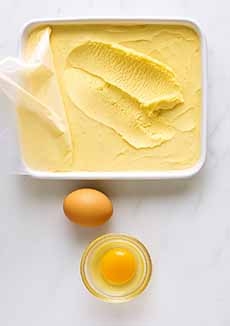
This is frozen custard (photo by ChatGPT 2025-05-13).
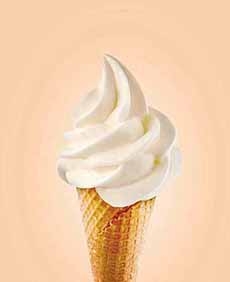
This is NOT frozen custard. It is soft-serve (photo © Sombench |Pexels).
|
For more on frozen custard, see our Ice Cream & Frozen Desserts Glossary.
Continue To Page 4: Terms With G ~ P
Go To The Article Index Above
|
